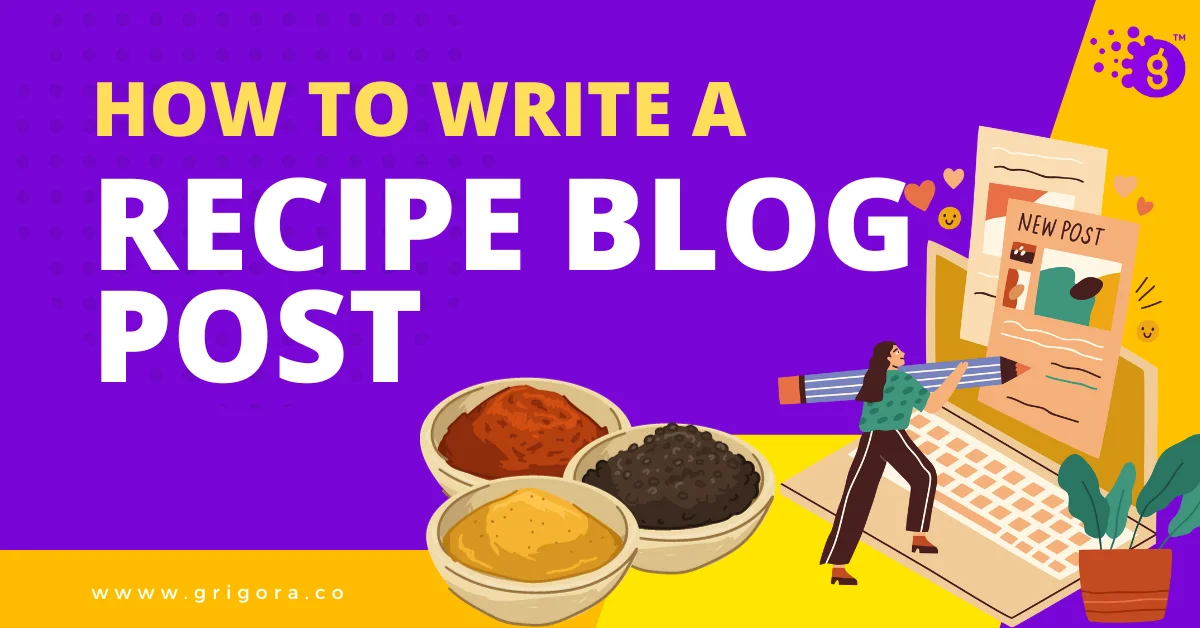Introduction
"Food is symbolic of love when words are inadequate." - Alan D. Wolfelt
The Versatility of Recipe Blogging
The beauty of recipe blogging lies in its versatility. Gone are the days when a recipe post was merely a static list of ingredients followed by a set of instructions. Today, it can be a narrative that tells the story of your grandmother's secret sauce, a scientific explanation of why certain flavors work well together, or a travel diary that explores the culinary delights of a specific region. This versatility not only enriches your blog content but also makes it appealing to a broader audience with varied interests.
Why Knowing Multiple Approaches to Recipe Blogging Can Be Beneficial
Understanding the different styles and formats of recipe blogging can significantly enhance your blog's appeal and reach. Each approach offers unique benefits and caters to specific reader needs. For instance, a storytelling recipe post can captivate readers who love a good narrative, while a science-backed post can attract those curious about the chemistry behind cooking. By diversifying your approach, you not only keep your existing readers engaged but also attract new ones. Moreover, it allows you to showcase your expertise and creativity in different aspects of cooking and writing.
The Classic Recipe Post
The Traditional Format: Introduction, Ingredients, Method
The classic recipe post is the backbone of any recipe blog. It's straightforward, easy to follow, and focuses solely on the recipe itself. This format typically includes an introduction that briefly describes the dish, a list of ingredients, and a step-by-step method for preparation. The classic recipe post is ideal for dishes that don't require much context or explanation, allowing the food to speak for itself.
When to Use This Approach
The traditional format is best suited for recipes that are straightforward and don't require much backstory or explanation. It's also the go-to format for readers who prefer getting straight to the point without any distractions. If you're sharing a recipe that has been passed down through generations or a dish that is widely recognized and loved, the classic recipe post is the way to go.
The Storytelling Recipe Post
Incorporating Personal Stories or Anecdotes
The storytelling recipe post is where you can let your personality shine through. This format allows you to weave personal stories, memories, or anecdotes into the recipe, providing a richer context for the dish. The storytelling approach adds an emotional layer to the recipe, making it more relatable and engaging for your readers.
How to Seamlessly Blend Story and Recipe
The key to a successful storytelling recipe post is balance. You don't want the story to overshadow the recipe or vice versa. Start by introducing the story and then transition smoothly into the recipe. Use subheadings or visual cues to help readers navigate between the story and the cooking steps. This format is perfect for recipes that have a personal or cultural significance to you.
The Themed Recipe Post
Creating a Recipe Around a Specific Theme or Occasion
Themed recipe posts are fantastic for seasonal cooking, holidays, or special occasions. For example, you could create a post around "Healthy Summer BBQ Recipes" or "Vegan Christmas Dinner Ideas." The theme not only adds a fun twist but also makes the post timely and relevant, increasing its shareability.
Examples: Holiday Recipes, Seasonal Ingredients
When writing a themed recipe post, it's a good idea to provide examples or variations that fit the theme. For instance, if your post is about "Quick and Easy Halloween Treats," you could include recipes for spooky cupcakes, a pumpkin smoothie, and a 'bloody' beetroot dip. This gives your readers multiple options to explore within the same theme, making your post a go-to resource for that particular occasion.
The Problem-Solving Recipe Post
Addressing a Common Cooking Challenge
Problem-solving recipe posts are designed to tackle specific challenges or questions that home cooks often face. For example, you could write a post on "How to Make Gluten-Free Bread That Doesn't Crumble." This type of post is incredibly valuable because it addresses a specific problem and offers a solution, making it highly searchable and shareable.
How This Adds Value to Your Readers
By solving a problem, you're directly adding value to your readers' lives. They come away from your post with new knowledge and a solution to a challenge they've been facing. This not only builds trust but also positions you as an authority in your niche.
The Listicle Recipe Post
Combining Multiple Recipes into a Single Post
Listicle recipe posts are excellent for readers who are looking for variety or meal planning ideas. For instance, you could write a post like "10 Quick Breakfast Recipes for Busy Mornings." This format allows you to showcase multiple recipes in one post, making it a rich resource for your readers.
Ideal for Meal Planning or Recipe Roundups
Listicles are perfect for meal planning because they offer multiple options for the reader to choose from. They're also great for seasonal or holiday roundups like "5 Must-Try Pumpkin Recipes for Fall." The key to a successful listicle is to ensure that each recipe or tip you include is valuable on its own but also contributes to the larger theme of the post.
The Video Recipe Post
Incorporating Video Content for Demonstrations
In the age of YouTube and Instagram, video content is king. Adding a video to your recipe post can make the cooking process easier to understand for your readers. Videos are particularly useful for complex recipes where visuals can help clarify certain steps. You don't need a professional setup; even smartphone videos can be effective if done well.
Tips for Shooting and Editing Cooking Videos
Creating a video requires some planning. Think about the best angles for each step of the recipe, and consider adding text overlays to clarify measurements or techniques. Editing is crucial; keep the video concise and engaging. If you're new to video editing, there are plenty of online tutorials to help you get started.
The Interview-Style Recipe Post
Featuring a Recipe from a Guest Chef or Food Blogger
An interview-style recipe post can add a fresh perspective to your blog. This format allows you to feature a recipe from a guest chef or another food blogger. It's a win-win situation: you get unique content, and your guest gets exposure. Conduct an interview to discuss the inspiration behind the recipe, cooking tips, or even their culinary journey.
How to Conduct and Incorporate the Interview
Conducting the interview can be done via email, phone, or even a video call. Prepare questions in advance and let the conversation flow naturally. Once the interview is complete, weave the insights and quotes into your blog post, making sure it complements the recipe.
The Review-Driven Recipe Post
Creating a Recipe Based on a Product Review
In this type of post, you create a recipe that centers around a specific product that you're reviewing. This could be a kitchen gadget, a type of ingredient, or even a cooking app. The key here is to provide an honest review while showing how the product can be effectively used in a recipe.
How to Maintain Authenticity and Trust
Transparency is crucial in review-driven posts. Make sure to disclose any partnerships or sponsorships with the brand you're reviewing. Your readers trust your opinion, so it's essential to provide an unbiased review, even if you received the product for free or are being paid for the post.
The Travel-Inspired Recipe Post
Sharing Recipes Inspired by Your Travels
Traveling exposes you to a variety of cuisines and cooking techniques. In a travel-inspired recipe post, you can share a recipe that you discovered or were inspired by during your travels. This is a great way to take your readers on a culinary journey without leaving their kitchen.
How to Talk About Cultural Context Respectfully
When writing about recipes from different cultures, it's crucial to do so respectfully and knowledgeably. Do your research to understand the cultural significance of the dish and give credit where it's due. This will not only educate your readers but also honor the culture that has inspired you.
The Science-Backed Recipe Post
Explaining the Science Behind the Cooking Process
Some recipes involve complex cooking techniques or unusual ingredients that may require a bit of scientific explanation. In a science-backed recipe post, you can delve into the chemistry or physics behind the cooking process. This is an excellent way to provide your readers with a deeper understanding of what happens when they're cooking and why.
Ideal for More Complex or Unusual Recipes
If you're tackling a recipe that involves a lot of steps or a cooking technique that's not commonly known, a science-backed post can be particularly helpful. It allows you to break down the process into understandable parts, making it easier for your readers to successfully replicate the recipe.
The Collaborative Recipe Post
Working with Other Bloggers or Brands
Collaboration can bring a fresh perspective to your blog and attract a new audience. In a collaborative recipe post, you can feature recipes from other bloggers or create a recipe using a brand's product. This type of post not only diversifies your content but also offers opportunities for cross-promotion and increased visibility.
How to Choose the Right Partners and Structure the Post
Choosing the right partners is crucial for a successful collaborative post. Make sure the blogger or brand aligns with your blog's ethos and audience. Once you've chosen a partner, discuss the structure of the post, whether it will be an interview format, a guest post, or a co-created recipe.
Managing Your Recipe Blog with Grigora
Why Grigora is an Ideal Platform for Recipe Bloggers
In the world of recipe blogging, managing content effectively is crucial for success. Grigora offers a wide range of features that make it an ideal platform for recipe bloggers. From user-friendly interfaces to robust security measures, Grigora stands as a transformative platform that unlocks endless possibilities for creativity and growth.
Features of Grigora That Simplify Blog Management and Enhance User Experience
Grigora provides a host of features designed to simplify blog management. These include customizable templates suitable for recipe blogs, SEO optimization tools, and robust analytics to track your blog's performance. With Grigora, you can focus more on creating delectable recipes and engaging content while the platform takes care of the technical aspects.
Conclusion
The Importance of Varying Your Recipe Blogging Approach
In the ever-evolving landscape of recipe blogging, versatility is key. Being able to adapt and present your recipes in various formats not only keeps your content fresh but also caters to a broader audience. Whether you're telling a story, solving a problem, or collaborating with other bloggers, each approach offers a unique angle to engage your readers.
Encouraging Readers to Experiment with Different Formats
As you diversify your recipe blogging styles, encourage your readers to experiment as well. Invite them to share their experiences and preferences, creating a more interactive and community-driven blog. This not only enhances user engagement but also provides you with valuable insights into what your audience prefers.
FAQs
How do I choose the right format for my recipe post?
Choosing the right format depends on the recipe itself and the message you want to convey. Consider the complexity of the recipe, the story behind it, and what you think will engage your readers the most.
Can I mix and match different styles in one blog?
Absolutely. Mixing different styles can make your blog more engaging. For instance, you could combine a video tutorial with a storytelling element to provide both visual aid and narrative depth.
How do I incorporate SEO into different types of recipe posts?
SEO is crucial regardless of the post type. Use relevant keywords, meta descriptions, and high-quality images with alt text to improve your blog's SEO.
What are the best practices for multimedia content like photos and videos?
Quality is key when it comes to multimedia content. Ensure good lighting and clarity for your photos and videos. Also, keep videos short and to the point to hold the viewer's attention.
How can Grigora assist in building and maintaining a recipe blog?
Grigora offers a range of features that simplify blog management. From easy-to-use templates to robust analytics tools, Grigora provides everything you need to run a successful recipe blog.
Additional Resources
Books on Creative Writing and Food Photography
If you're looking to improve your writing or photography skills, there are numerous books available that focus on these subjects. "The Elements of Style" by Strunk and White is a classic for any writer, while "Plate to Pixel" by Helene Dujardin offers great insights into food photography.
Online Courses on Advanced Recipe Blogging Techniques
There are various online platforms like Udemy, Coursera, and Skillshare that offer courses on blogging and food photography. These courses can provide you with advanced techniques to make your blog stand out.
Forums and Communities for Recipe Bloggers
Joining forums and online communities can provide you with valuable insights and a platform to share your work. Websites like Food Blogger Pro offer a community and resources specifically geared towards food bloggers.



